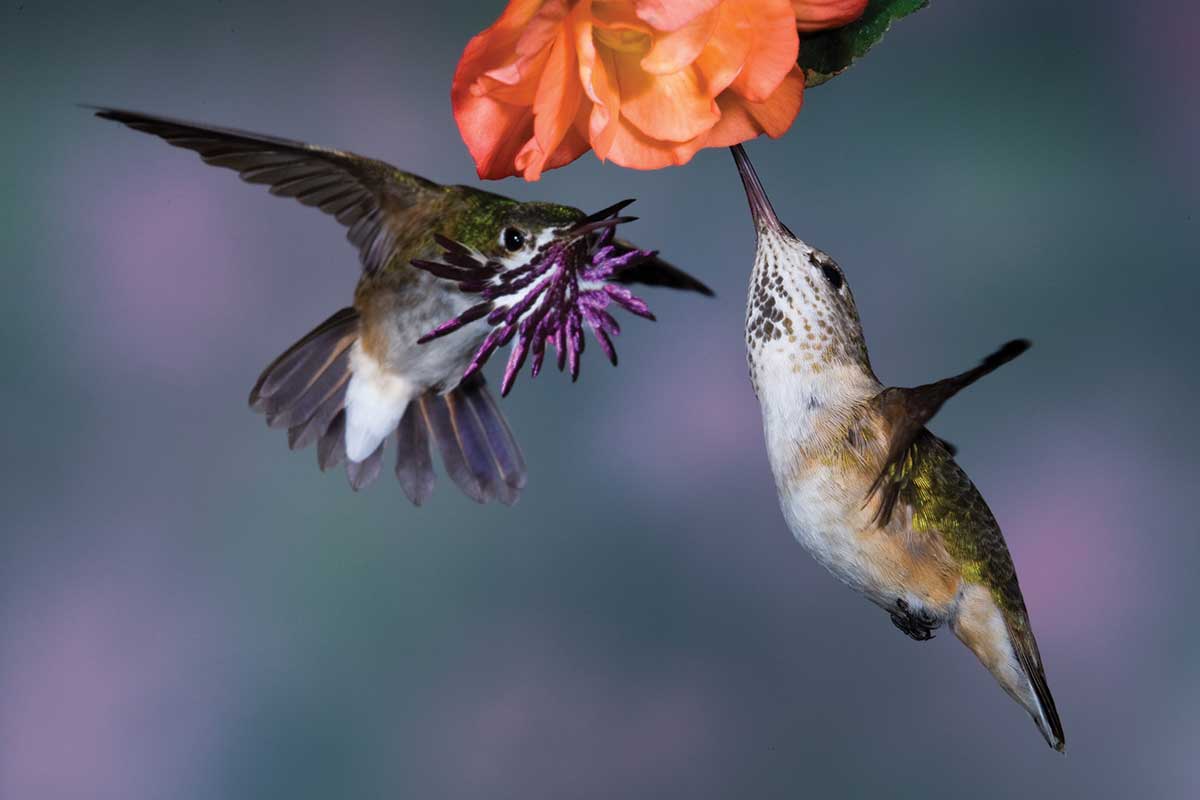It’s just about that time again—when patio-sitters, backyard bird-watchers and, yes, even cats gather to watch the annual migration of nature’s smallest bird: the hummingbird.
Professional and amateur birdwatchers have documented over two dozen different species of hummingbirds in the U.S. Texans, depending on where they are, can catch sight of eight species either passing through during migration or simply staying at home in our state. Because Texas is located within two major migration flyways, nine additional species have been sighted over the years, making Texas a great state for hummingbird lovers.
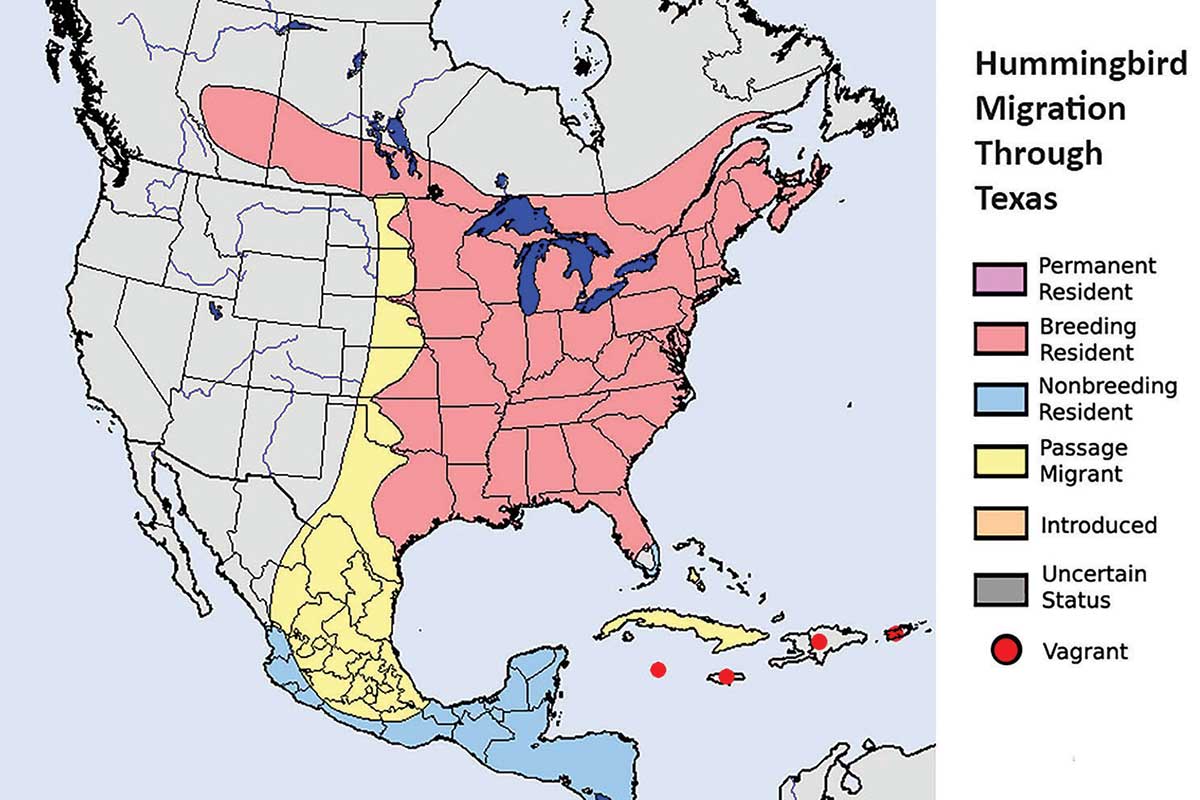
Texas falls right in the middle of the hummingbird migration, visiting the state twice a year, in the spring and the fall.
Texas is crossed by two major north-south bird migration flyways, the Central Flyway, which traverses the Rockies, and the Mississippi Flyway, which parallels the river. Hummingbirds migrate along both flyways to and from their destinations.
When hummingbirds leave Texas to fly south to Mexico and Central America, they travel nonstop over the Gulf of Mexico before hitting land on the Yucatan Peninsula. An average North American hummingbird can fly about 1,200 miles at an average speed close to 60 miles per hour without stopping. Their tiny wings beat 53 times per second, enough to power them on these long treks. Offshore oil workers in the Gulf regularly report hummingbirds taking a breather along the way, but for the most part, it’s a continuous 20-hour flight.
A few breeds come up from Mexico and Central America headed for summer breeding grounds in western Canada and Alaska, while others flock to the Great Lakes and Canada. Most species migrate into Texas from the south between February and April, then return on their southern migration, staying in Texas until the first cold north wind of fall.
To make their long journey, hummingbirds must first fill up on nourishment, which can come in the form of nectar, provided by humans or flowers, or smaller insects.
Most people think hummingbirds only sip on nectar, but they’re wrong. The tiny birds are fast and agile hunters of small insects. In fact, most hummingbird young are fed insects for the protein.
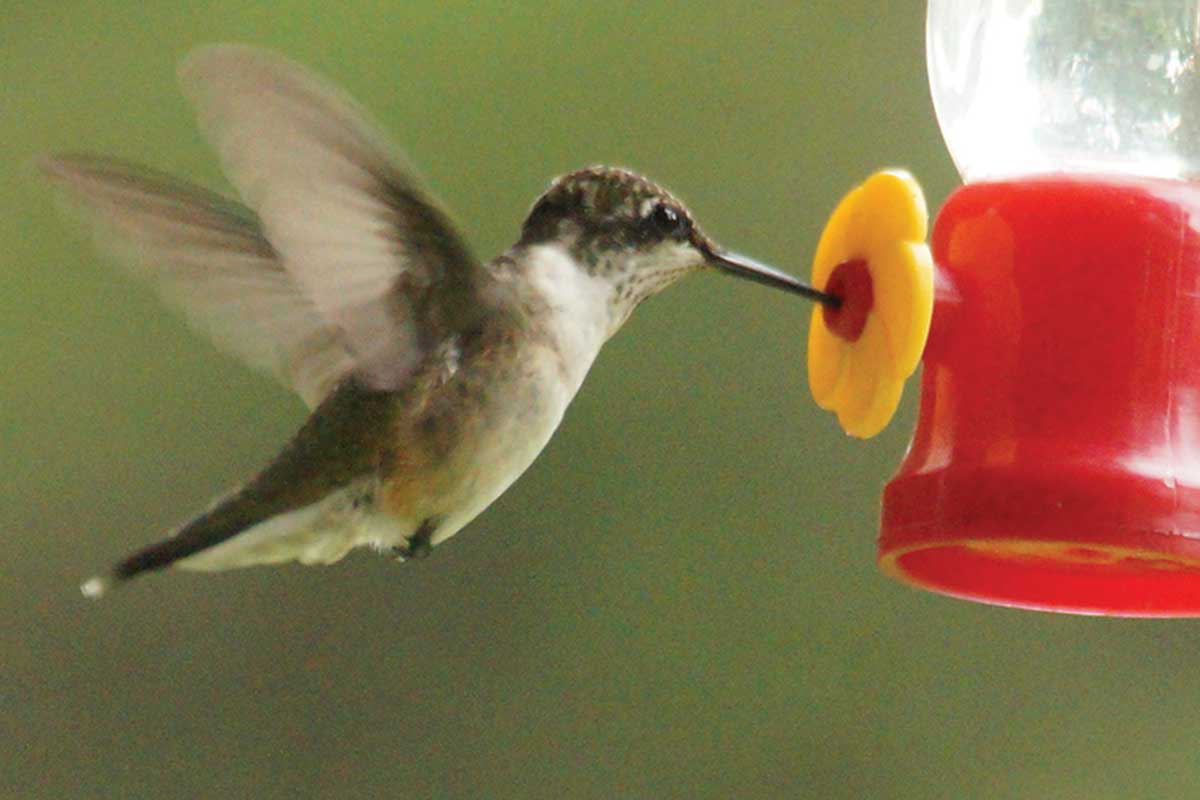
This ruby-throated hummingbird is drinking clear nectar. While hummingbirds are attracted to the color red, experts advise strongly against using red food coloring in nectar, which causes harm to their delicate systems.
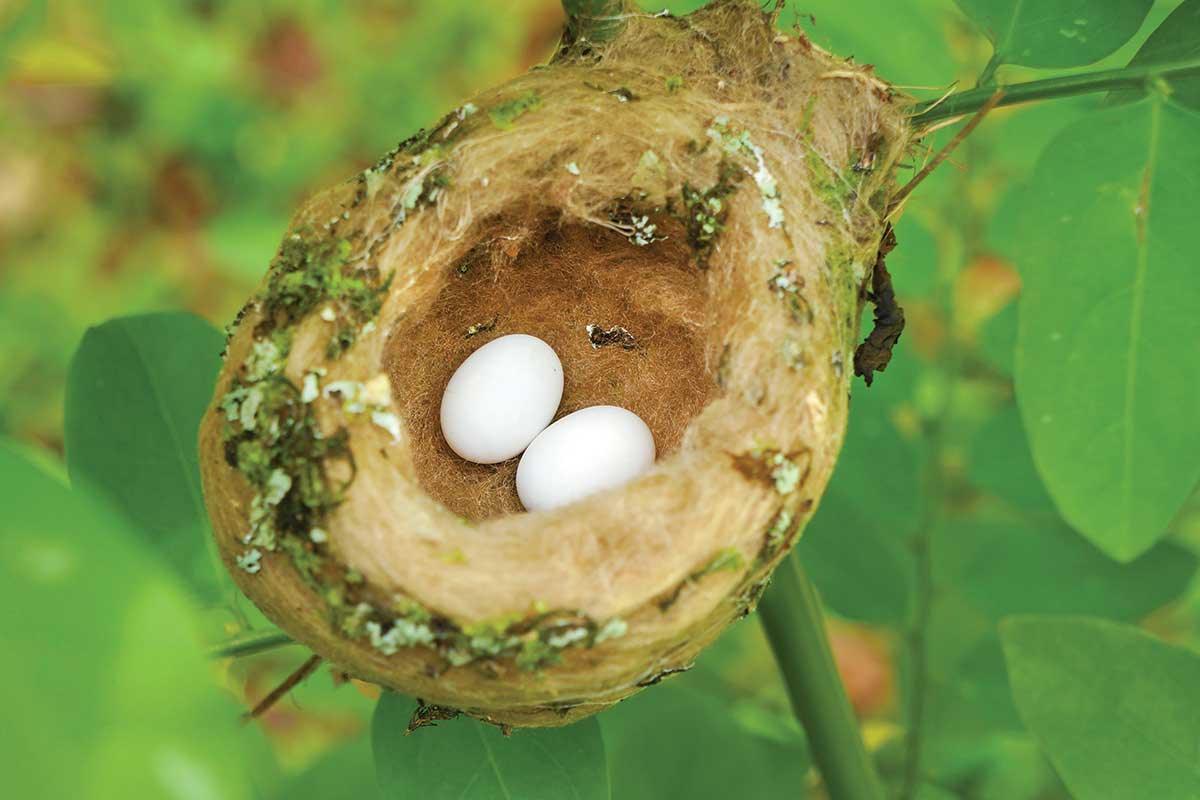
Hummingbirds have very small nests, usually hidden to keep predators from stealing the eggs, which are about the size of jellybeans.
All hummingbirds are busy pollinators as they sip nectar. Their long beaks are designed to dip into tubular flowers like salvias, hibiscus, Hamelia patens (hummingbird or fire bush) and bee balm. Their long tongues can flick 13–17 times per second when feeding on nectar.
Their tiny nests are the things of fairy stories, made of plant down and spider silk to hold them together as they lie atop small branches or twigs, almost always low to the ground. The rufous hummingbird is known to build its tiny nests in the tops of trees. If you do find a nest, you might see one to three tiny white eggs that are only about a half-inch in length.
Once hatched, most hummingbirds live 3–5 years. One might think they are easy pickings for birds of prey, but their flight speed generally gives them protection. In general, eagles only fly at about 30 miles per hour, but when they dive, they can reach speeds up to 150 miles per hour.
Since hummingbirds generally hit a maximum flight height of about 500 feet (compared to eagles, which can go as high as 20,000 feet), most of their danger comes from above. In Texas, one of their biggest predators are cats, which most often know exactly where hummingbird feeders are hanging, and they lay in wait for just the right moment to pounce.
There are no species of hummingbird classed as “permanent residents” in Texas. However, ruby-throated, black-chinned, buff-bellied and rufous hummingbirds have all been recorded as remaining all year, which explains why some hummingbird enthusiasts keep their feeders filled year-round.
While their arrival can vary slightly each year because of weather and by species, most begin arriving in Texas for their first migration between February and April and for their return migration right about now, so get those feeders ready. Speaking of feeders, please see the sidebar to get the right recipe for making hummingbird nectar (hint: it’s not red).
The following list of Texas hummingbirds was compiled using range maps and information from Cornell University. You’ll find the eight hummingbirds that are regularly seen across Texas with a short description of each.
Ruby-Throated Hummingbird
Length: 2.8–3.5 inches
Weight: 0.1–0.2 ounces
Wingspan: 3.1–4.3 inches
The most common hummingbird in East Texas, ruby-throated hummingbirds are the only species that do their breeding in eastern North America. Males begin arriving in late February to mid-March, followed by the females ready to breed. In the fall, ruby-throats gather in August and September along the Texas Gulf Coast before making their final push south to Mexico and Central America for winter.
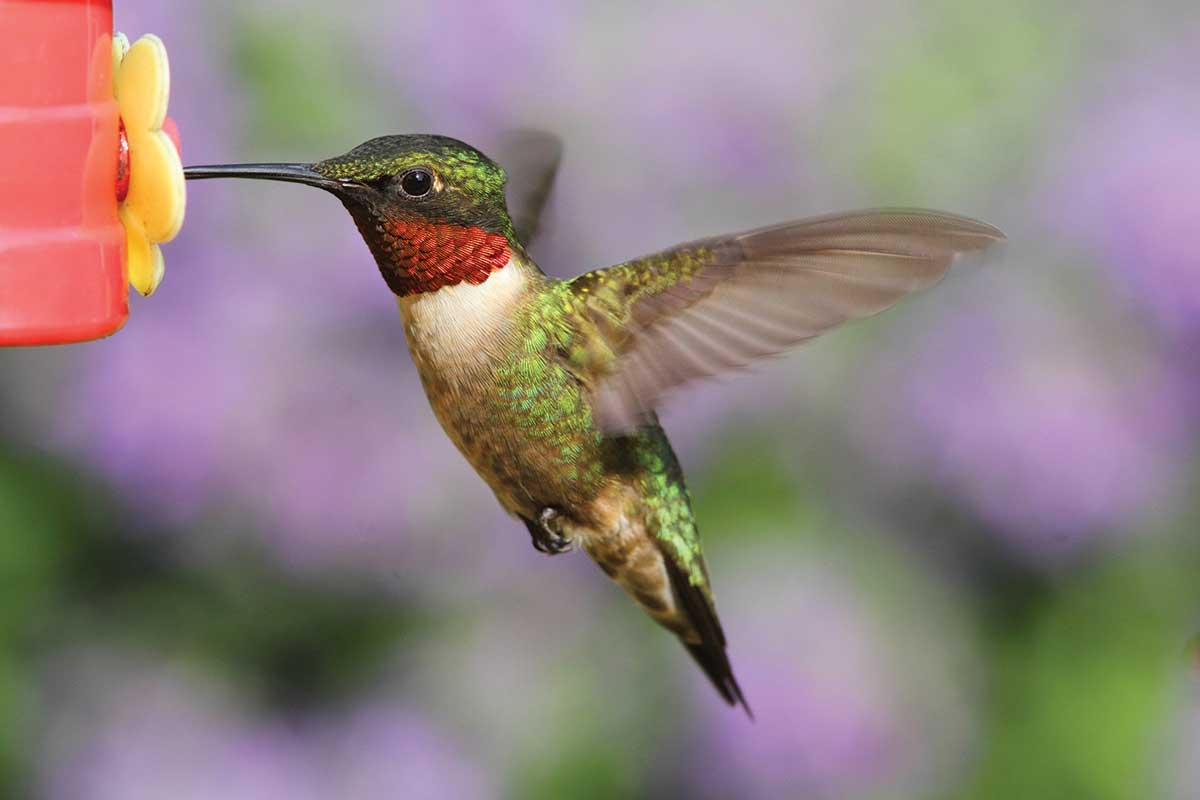
Beating their wings at an average of 50 times per second, hummingbirds can hover while drinking nectar, licking with their very long tongues at a rate of 13–17 times per second.
Broad-Tailed Hummingbird
Length: 3.1–3.5 inches
Weight: 0.1–0.2 ounces
Wingspan: 5.25 inches
Broad-tailed hummingbirds live in the higher elevations of far West Texas but can be seen during migration in the north of the state. Females are iridescent green on the back, brownish in the wings and white on the chest, and males have an iridescent rose throat. They breed in high meadows and open woodlands between 5,000 and 10,000 feet elevation from late May through August before migrating to southern Mexico for the winter. Due to the cooler temperatures at higher elevations, the broad-tails can slow their heart rate and drop their body temperature to enter a state of torpor.
Buff-Bellied Hummingbird
Length: 3.9–4.3 inches
Weight: 0.1 ounces
Wingspan: 5.75 inches
Only found in southern and southeastern Texas, buff-bellied hummingbirds will winter along the Gulf Coast, ranging into Louisiana and as far east as Florida. This makes them less common than other species in Texas. They breed in South Texas and the Yucatan Peninsula of Mexico through Central America. Semiopen habitats or woodland edges are ideal for buff-bellied hummingbirds, and they will also visit backyards for flowers or nectar feeders.
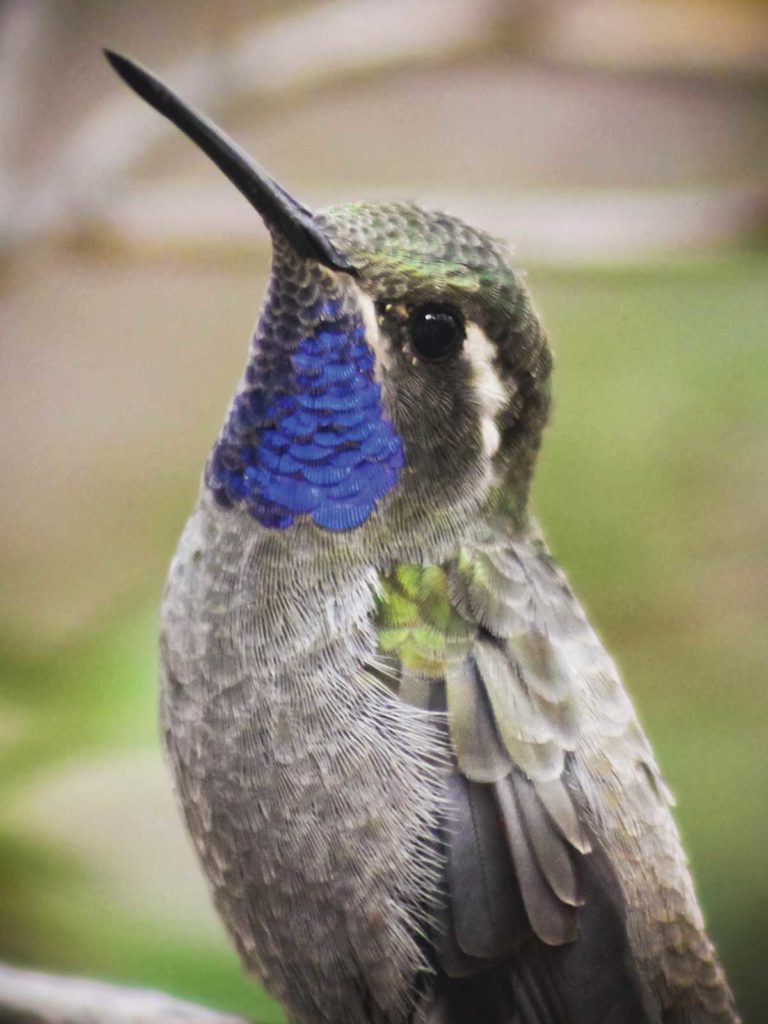
The blue-throated mountain gem hummingbird generally is found in the Big Bend area of Texas, but sightings have been seen as far east as the Hill Country.
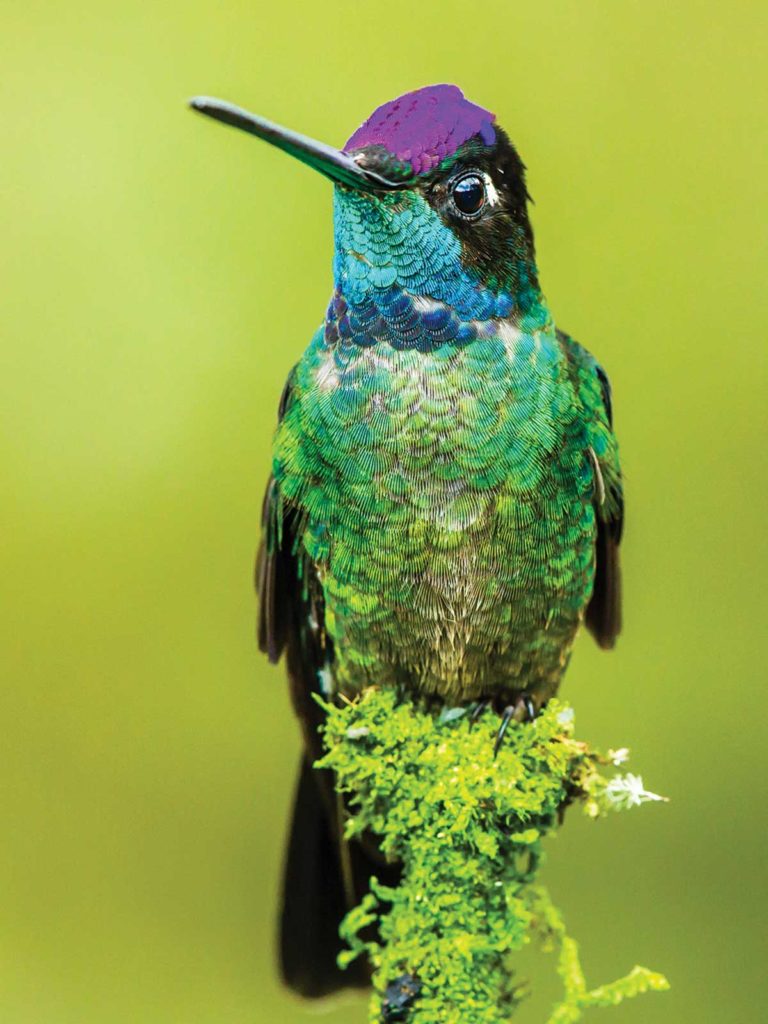
While only seen in Texas on rare occasions, the magnificent hummingbird certainly lives up to its name.
Blue-Throated Mountain Gem
Length: 4.3–4.7 inches
Weight: 0.3 ounces
Wingspan: 2.3–3.1 inches
Blue-throated hummingbirds, also known as blue-throated mountain gems, have a very limited range in the U.S. The only three states where they can be found are Texas (in Big Bend National Park), New Mexico and Arizona. They are most prominent in Arizona’s southeastern corner, with Texas and New Mexico having only a few small areas where they are occasionally seen.
Black-Chinned Hummingbird
Length: 3.5 inches
Weight: 0.1–0.2 ounces
Wingspan: 4.3 inches
Black-chinned hummingbirds are common in all of central and western Texas. They migrate north from Mexico and Central America each year and breed in the eastern U.S. from Texas to Idaho and every state west of that line.
Calliope Hummingbird
Length: 3.1–3.5 inches
Weight: 0.1 ounces
Wingspan: 4.1–4.3 inches
Calliope hummingbirds only pass through western parts of Texas like Big Bend National Park and El Paso during migration. They migrate to the Pacific Northwest and parts of western Canada to breed. Among the smallest hummingbirds in North America (they weigh about the same as a ping-pong ball), calliopes will pass back through Texas by late September or early October.
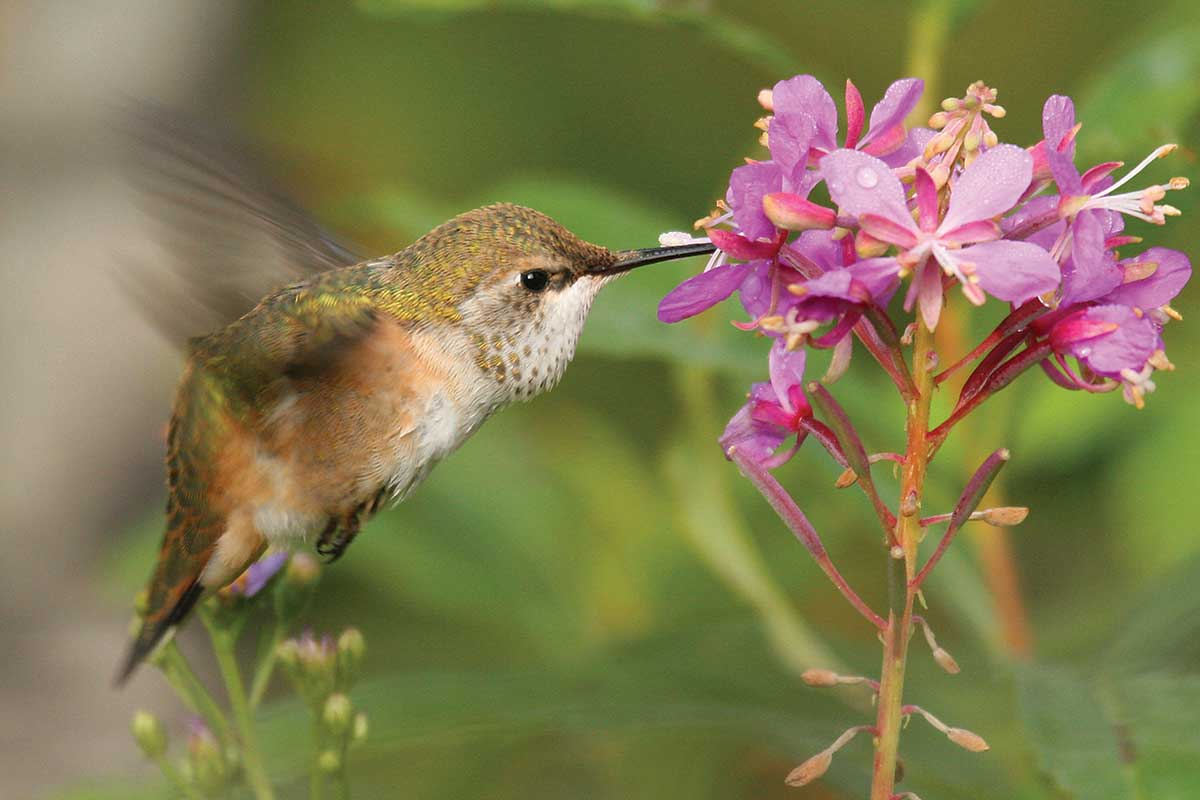
The rufous hummingbird is the second-most common hummingbird to make its way through East Texas during migration season.
Rufous Hummingbird
Length: 2.8–3.5 inches
Weight: 0.1–0.2 ounces
Wingspan: 4.3 inches
Rufous hummingbirds also pass through the western half of Texas during migrations. If you live west of the Dallas-Fort Worth area, then you might get lucky, but they generally just stop for a week or two then move on, so keep an eye out. Rufouses’ migrations are among the longest of any species, traveling up to 4,000 miles each way, breeding in northwest Alaska and migrating to Mexico’s Gulf Coast for winter. They also migrate north along the Pacific Coast in the spring and by the Rocky Mountains in late summer and fall.
Lucifer Hummingbird
Length: 3.5 inches
Weight: 0.1 ounces
Wingspan: 4 inches
Lucifer hummingbirds have a breeding population in the Big Bend National Park area of Texas. They are also found in extreme southern New Mexico and Arizona near the border, but that is it for the U.S. Birdwatchers find Lucifers in these areas starting in early March through as late as early November each year. They can be identified by a downward-curved bill and long, forked tails; the males have a purple throat.
Other hummingbirds make rare appearances in Texas during the year, and their sightings are always welcomed by bird-watchers and backyard amateurs alike. The nine rarities include Anna’s, broad-billed, magnificent, Allen’s, white-eared, Mexican violetear, violet-crowned and berylline hummingbirds as well as the Mexican violetear and green-breasted mango.
